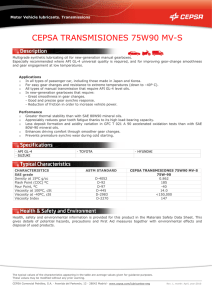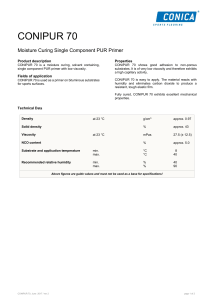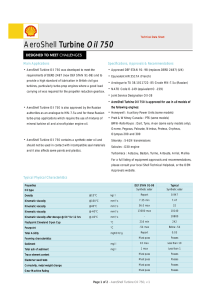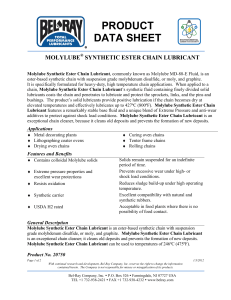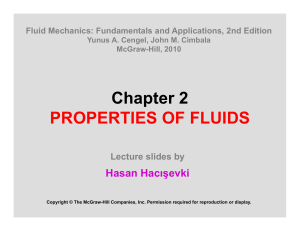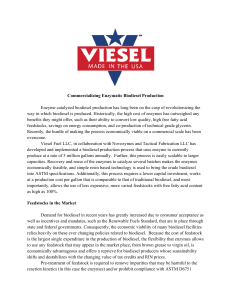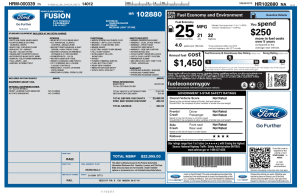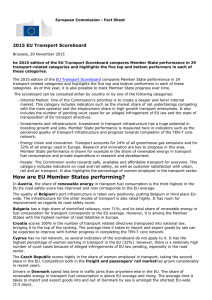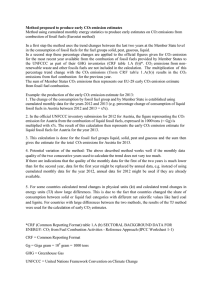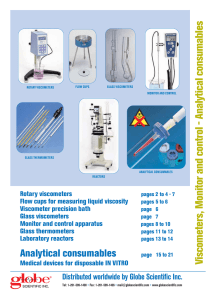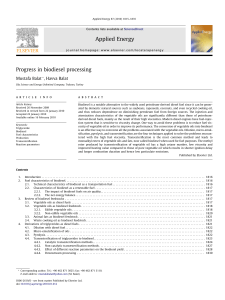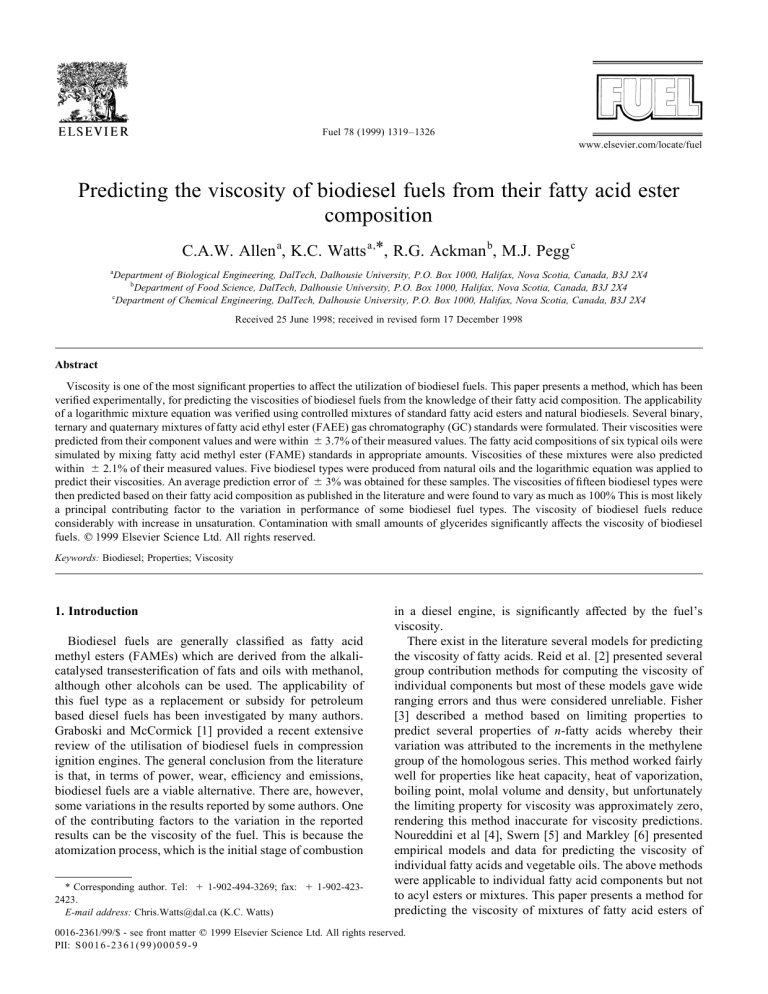
Fuel 78 (1999) 1319–1326 www.elsevier.com/locate/fuel Predicting the viscosity of biodiesel fuels from their fatty acid ester composition C.A.W. Allen a, K.C. Watts a,*, R.G. Ackman b, M.J. Pegg c a Department of Biological Engineering, DalTech, Dalhousie University, P.O. Box 1000, Halifax, Nova Scotia, Canada, B3J 2X4 b Department of Food Science, DalTech, Dalhousie University, P.O. Box 1000, Halifax, Nova Scotia, Canada, B3J 2X4 c Department of Chemical Engineering, DalTech, Dalhousie University, P.O. Box 1000, Halifax, Nova Scotia, Canada, B3J 2X4 Received 25 June 1998; received in revised form 17 December 1998 Abstract Viscosity is one of the most significant properties to affect the utilization of biodiesel fuels. This paper presents a method, which has been verified experimentally, for predicting the viscosities of biodiesel fuels from the knowledge of their fatty acid composition. The applicability of a logarithmic mixture equation was verified using controlled mixtures of standard fatty acid esters and natural biodiesels. Several binary, ternary and quaternary mixtures of fatty acid ethyl ester (FAEE) gas chromatography (GC) standards were formulated. Their viscosities were predicted from their component values and were within ^ 3.7% of their measured values. The fatty acid compositions of six typical oils were simulated by mixing fatty acid methyl ester (FAME) standards in appropriate amounts. Viscosities of these mixtures were also predicted within ^ 2.1% of their measured values. Five biodiesel types were produced from natural oils and the logarithmic equation was applied to predict their viscosities. An average prediction error of ^ 3% was obtained for these samples. The viscosities of fifteen biodiesel types were then predicted based on their fatty acid composition as published in the literature and were found to vary as much as 100% This is most likely a principal contributing factor to the variation in performance of some biodiesel fuel types. The viscosity of biodiesel fuels reduce considerably with increase in unsaturation. Contamination with small amounts of glycerides significantly affects the viscosity of biodiesel fuels. q 1999 Elsevier Science Ltd. All rights reserved. Keywords: Biodiesel; Properties; Viscosity 1. Introduction Biodiesel fuels are generally classified as fatty acid methyl esters (FAMEs) which are derived from the alkalicatalysed transesterification of fats and oils with methanol, although other alcohols can be used. The applicability of this fuel type as a replacement or subsidy for petroleum based diesel fuels has been investigated by many authors. Graboski and McCormick [1] provided a recent extensive review of the utilisation of biodiesel fuels in compression ignition engines. The general conclusion from the literature is that, in terms of power, wear, efficiency and emissions, biodiesel fuels are a viable alternative. There are, however, some variations in the results reported by some authors. One of the contributing factors to the variation in the reported results can be the viscosity of the fuel. This is because the atomization process, which is the initial stage of combustion * Corresponding author. Tel: 1 1-902-494-3269; fax: 1 1-902-4232423. E-mail address: [email protected] (K.C. Watts) in a diesel engine, is significantly affected by the fuel’s viscosity. There exist in the literature several models for predicting the viscosity of fatty acids. Reid et al. [2] presented several group contribution methods for computing the viscosity of individual components but most of these models gave wide ranging errors and thus were considered unreliable. Fisher [3] described a method based on limiting properties to predict several properties of n-fatty acids whereby their variation was attributed to the increments in the methylene group of the homologous series. This method worked fairly well for properties like heat capacity, heat of vaporization, boiling point, molal volume and density, but unfortunately the limiting property for viscosity was approximately zero, rendering this method inaccurate for viscosity predictions. Noureddini et al [4], Swern [5] and Markley [6] presented empirical models and data for predicting the viscosity of individual fatty acids and vegetable oils. The above methods were applicable to individual fatty acid components but not to acyl esters or mixtures. This paper presents a method for predicting the viscosity of mixtures of fatty acid esters of 0016-2361/99/$ - see front matter q 1999 Elsevier Science Ltd. All rights reserved. PII: S0016-236 1(99)00059-9 1320 C.A.W. Allen et al. / Fuel 78 (1999) 1319–1326 which biodiesel is comprised. The importance of this work is that if it is possible to predict the viscosity of any given vegetable oil source from its components (and hence its atomization), there may be no need for expensive testing programmes to determine the functioning of the oil in an engine. 2. Mixture model The Grunberg–Nissan [7] equation has been reported by Monnery et al. [8] and Irving [9] to be the most suitable equation for computing the viscosity of liquid mixtures. This equation was developed primarily for binary mixtures and works best with non-associated liquids. However, good results were obtained by Irving [9] for some associated fluids with errors less than 5–10%. This equation has also been extended beyond the binary mixture level with some success ([9]). The Grunberg–Nissan equation is ln mm n X xi ln mi 1 i XnX xi xj Gij 1 i±j where mm is the mean viscosity of mixture (Pa s), m the viscosity of pure ith component (Pa s), xi and xj the mole fractions of the ith and jth components, Gij the interaction parameter (Pa s) n the number of components. Biodiesel fuels are non-associated liquids that are comprised of mixtures of fatty acid esters whose chemical structures are similar (aliphatic chains). Due to this similarity, the components in a mixture should not interact with each other and thus should behave in a similar manner as an individual component. It was therefore assumed that the interaction parameter in Eq. (1) would be small and thus could be neglected. Also, the mass fraction was used in preference to the mole fraction in Eq. (1) to conform with the mass unit that is implicit in the units for viscosity used in this study. With these two modifications, Eq. (2) was used to predict the viscosity of biodiesel fuels based on their fatty acid composition. ln mm n X yi ln mi 2 i1 where yi is the mass fraction. 3. Materials and methods 3.1. Sample preparation Both FAME and ethyl ester (EE) standards were acquired from Sigma Aldrich Chemical Supplies company. EEs were used for binary, ternary and quaternary mixtures since it was more economical to use these standards. The following samples were prepared for different tests, as described later: • Twenty EE samples were produced by mixing, on a mass basis, varying proportions of 8:0, 10:0, 12:0 and 18:1 FAMEs. • MEs were mixed on a mass basis in appropriate proportions to simulate canola, coconut, palm, peanut, rapeseed and soybean oil MEs. • Biodiesel fuels from natural canola, coconut, palm, peanut and soya oils were produced in a batch transesterification unit described by Allen and Watts [10]. These ME fuels were also heated to 1008C under nitrogen and then filtered through a “Reeve Angel” grade 202 coarse paper filter to remove any sediments in the oil that were carried over from the oil extraction process. At 1008C, all of the oil’s fatty acids were fluid with low viscosity, making it easier for them to pass through the coarse filter. The purity of the biodiesel fuels produced by the transesterification process was verified using a thin-layer chromatography (TLC) on Chromarods-SIII (silica gel) with flame ionization of the components (TLC-FID) by scanning in an Iatroscan Mark III ([11]). The fatty acid composition of the biodiesel fuels was measured on a Perkin–Elmer Gas Chromatograph, model 8420 as described by Ackman [12]. 3.2. Viscosity measurement A Paar model AMV 200 micro viscometer operating on a rolling-ball principle was used to measure the viscosity of all samples at the test temperature. Only one replicate for each sample was required as the instrument provided consistently repeatable results. 3.3. Error analysis The maximum allowable error for the predicted results was derived through a sensitivity analysis of a generalized atomization model taken from the literature. This model, which was developed by Msipa et al. [13], computes an atomization characteristic Ka which gives an overall view of the atomization quality. It includes the surface tension, viscosity and density of the fuel. Eqs. (3)–(5) summarise this model and further details can be found in Ref. [13]. " #1=3 rf Wef Ka 3 rg Ref where Ka is the atomization characteristic, Wef the Weber number for fuel, Ref the Reynolds number for fuel, r the densities for fuel [r f] and gas atmosphere [r g] (kg/m 3). The Reynolds and Weber numbers are given by Ref V 0 d0 vf 4 Wef rf V02 d0 sf 5 where s f is the surface tension of the fuel (N/m), vf the C.A.W. Allen et al. / Fuel 78 (1999) 1319–1326 1321 Table 1 Mean value of properties used for sensitivity analysis was converted to an effective shear rate per unit rolling distance and is given in Eq. (8). Property Mean value g_ L Surface tension of fuel Viscosity of fuel Density of fuel Nozzle diameter 0.0292 N/m 4.18 mPa s 871.4 kg/m 3 0.4 mm 3.4. Rheological properties To ensure a correct comparison of the viscosities of different biodiesel types, a check was made to determine whether these fuels were significantly non-Newtonian at the test temperature of 408C. All of the biodiesel ME fuels produced were subjected to controlled, variable shear stress viscosity measurements on the rolling-ball viscometer and the effective shear rate was determined as a function of the rolling time. The effective shear rate and the effective shear stress for a rolling-ball viscometer [15] are given in Eqs. (6) and (7). Mean Velocity of Ball 4dV 2 Mean Gap area based D 2 d2 tE d Drgsin u 8 where g_ L is the equivalent shear rate per unit length (1/ (m s)) and t the rolling time of ball (s). kinematic viscosity of the fuel (m 2/s) and V0 the velocity of the fuel jet (m/s). Using the conventional 95% confidence, it was decided to vary the viscosity to a maximum of ^ 5% from its mean value to determine if there was any significant change in the atomization characteristic. The mean value of all properties, taken from Allen et al. [14], are given in Table 1. g_ E 4d D2 2 d2 t 6 7 where g_ E is the equivalent shear rate (1/s), t E the equivalent shear stress (Pa), D the capillary diameter (m), d the ball diameter (m), V the velocity of the rolling ball (m/s), Dr the difference in density between ball and fluid (kg/m 3), u the angle of inclination of capillary (8) and g the acceleration due to gravity (9.81 m/s 2). The viscometer measured the rolling time of the ball over a fixed distance. This distance was not known for the instrument used in these tests, therefore, the effective shear rate 4. Results and discussion 4.1. Allowable error Fig. 1 shows a graphical representation of the results of the sensitivity analysis. A ^ 5% variation in the viscosity resulted in a 3% variation in Ka from its maximum value. This 3% variation in Ka over the entire ^ 5% (10% variation from maximum viscosity) range of viscosities used can be considered negligible. Therefore, the maximum allowable error for a prediction equation to estimate the viscosities of the ester mixtures was set at 5%. 4.2. Rheological properties of experimentally produced biodiesel fuels For every biodiesel fuel type that was produced, a plot of the equivalent shear stress versus the equivalent shear rate per unit length was made (Fig. 2) and linear regression lines were then fitted to these points. For each fuel type, all the data points fell on their regression line which passed through a point very close to the origin (Fig. 2). This very small shear stress (yield stress) at zero flow indicates a slight “Bingham-plastic” behaviour which is more pronounced for peanut, palm and coconut oils. However, this effect is small and these fuels can, therefore, be considered to behave in a Newtonian manner at 408C which means that the higher saturates present in some of the oils did not significantly affect the nature of the fuel’s viscosity. Also, during the utilization of these vegetable oil ME fuels in engines, the shear stresses encountered are much higher than the yield stresses observed. Therefore, these fuels may be considered to behave in a Newtonian manner in actual engine operations. 4.3. Viscosity of individual ester components The measured viscosities of individual FAMEs and EEs had a complex pattern with respect to the saturation of the fatty acids and their chain length. For saturated fatty acid esters, the measured data at 408C indicated that the viscosity increased with carbon number (CN) in a curvilinear trend rather than a linear one. Good correlation was found between the measured data and a second-order polynomial function over the CN range 8:0–18:0. Eqs. (9) and (10) give the fitted polynomials for saturated MEs and EEs. Fig. 1. Variation of normalized atomization characteristic (Kai/Kamax) with 5% variation of viscosity for constant surface tension and density: (B) Ka and (K) % variation. mME2sat 1:05E 2 4M 2 2 0:0242M 1 2:15 s 0:0145 9 1322 C.A.W. Allen et al. / Fuel 78 (1999) 1319–1326 Fig. 3. Viscosity trend lines for methyl ester and ethyl ester GC standards at 408C: (A) EEs and (W) MEs. Fig. 2. Rheograms for vegetable oil methyl ester biodiesel fuels at 408C plotted on a linear scale: (W ) canola; (X) coconut; (K) diesel; ( 1 ) palm; (A) peanut; (B) soya. mEE2sat 1:16E 2 4M 2 2 0:0264M 1 2:28 s 0:0182 10 where m is the viscosity (mPa s), M the molecular weight (g/ mol) and s the standard error. Fig. 3 shows the data points and their trend curves. The viscosities of the saturated EEs were only slightly higher than those for MEs, an average of 5.4% higher over the CN range 8:0–18:0. The viscosity trend for unsaturated esters at 408C showed a sharp deviation from the trend of the saturated esters when 18:0 became unsaturated to 18:1. A completely different curve was observed as the degree of unsaturation progressed from 18:1 to 18:3 (Fig. 3). As the number of double bonds increased, there was a non-linear decrease in viscosity, with a 21% difference between 18:0 and 18:1 (based on 18:0), an 18% difference between 18:1 and 18:2 (based on 18:1), and a 13% difference between 18:2 and 18:3 (based on 18:2). Although this phenomenon was not verified at other CN due to the cost and availability of these individual components, there is no a priori reason why the same result would not occur at other CN since their chemical structures are similar. The trend for unsaturated C18 esters also correlated well with second-order polynomial functions given in Eqs. (11) Table 2 Viscosities of binary, ternary and quaternary mixtures of fatty acid ethyl ester GC standards at 258C Sample # Fatty acid ethyl ester Measured viscosity (mPa s) Predicted viscosity (mPa s) 5.50 2.88 1.99 1.37 1.67 1.91 2.39 1.51 1.82 1.62 2.32 2.19 2.62 1.94 1.77 1.91 2.12 2.51 3.31 2.62 2.32 2.01 – – – – 1.66 1.98 2.39 1.5 1.81 1.65 2.39 2.19 2.62 1.99 1.81 1.93 2.18 2.57 3.38 2.67 2.35 2.06 Per cent error Mass fraction 1 2 3 4 5 6 7 8 9 10 11 12 13 14 15 16 17 18 19 20 21 22 18:1 12:0 10:0 8:0 1.00 – – – – – – – – – – – – – – – – 0.25 0.52 0.16 0.16 0.16 – 1.00 – – – 0.50 0.50 – – 0.25 0.75 0.25 0.74 0.34 0.25 0.19 0.50 0.25 0.16 0.51 0.16 0.16 – – 1.00 – – – 1.00 0.48 0.50 0.52 0.50 0.25 0.75 – – 0.75 0.26 0.33 0.25 0.54 0.25 0.25 0.16 0.16 0.51 0.16 0.75 0.25 0.75 0.25 – – 0.33 0.51 0.27 0.25 0.25 0.16 0.16 0.16 0.51 – – – – 0.60 2 3.66 0.00 0.66 0.55 2 1.85 2 3.02 0.00 0.00 2 2.58 2 2.26 2 1.05 2 2.83 2 2.39 2 2.11 2 1.91 2 1.29 2 2.49 C.A.W. Allen et al. / Fuel 78 (1999) 1319–1326 1323 Table 3 Viscosities and mass fraction of simulated vegetable oil ME at 408C (using measured viscosities of pure components) Fatty acid methyl ester Viscosity (mPa s) Simulated vegetable oil methyl ester-component mass fraction Coconut Palm Rapeseed Peanut#1 Soybean Canola Peanut#2 a 0.000 0.000 0.000 0.000 0.106 0.010 (0.054) b 0.499 0.334 0.005 0.013 (0.000) b 0.031 (0.000) b 0.002 3.57 3.51 0.06 1.49 0.000 0.000 0.000 0.002 0.102 0.046 0.000 0.000 0.000 0.002 0.037 0.024 0.000 0.000 0.000 0.000 0.104 0.033 0.222 0.546 0.082 0.000 0.600 0.218 0.113 0.000 0.529 0.327 0.005 0.000 0.000 0.000 0.000 0.000 3.26 3.27 20.01 20.24 0.005 3.45 3.45 0 0.11 0.002 3.51 3.50 0.01 0.31 8:0 10:0 12:0 14:0 16:0 0.75 0.99 1.40 1.95 2.69 3.60 4.74 0.078 0.070 0.466 0.182 0.092 0.028 0.001 0.001 0.009 0.013 0.441 0.051 0.000 0.000 0.000 0.000 0.029 0.025 18:1 18:2 18:3 20:0 3.73 3.05 2.65 – 0.068 0.017 0.000 0.000 0.384 0.095 0.004 0.000 0.128 0.116 0.085 0.000 22:0 – 0.000 0.000 0.000 22:1 Measured viscosity (mPa s) Predicted viscosity (mPa s) Error (mPa s) Per cent error 5.91 0.000 2.15 2.19 20.04 22.04 0.000 3.59 3.59 0 20.08 0.617 4.7 4.72 20.03 20.57 a b Peanut#2 has no 22:0 and 20:0. Mass fraction after being combined with 18:0. and (12) for MEs and EEs, respectively. mME2unsat2C18 0:153 NDB 2 1:15 NDB 1 4:73 2 11 s 0:0112 mEE2unsat2C18 0:147 NDB2 2 1:09 NDB 1 4:82 12 s 0:000 where NDB is the number of double bonds in the C18 chain. 4.4. Measurement and prediction of the viscosity of mixtures of GC standards The logarithmic equation (Eq. 2) for predicting the viscosities of multi-component mixtures was tested by comparing measured and predicted viscosities of fatty acid ester standards. Initially, the model was tested using binary, ternary and quaternary mixtures of 8:0, 10:0, 12:0 and 18:1 EE standards at 258C. The mixing ratios and results are summarized in Table 2 where it can be seen that the errors in predicting the viscosities are all less than 3.7%, showing that the assumption of a negligible interaction parameter, and that the use of the measured mass fraction of the control samples provide acceptable results. It was thus decided to extend the verification procedure to more complex mixtures of MEs that simulated biodiesel fuels. The ME standards that were mixed on a mass basis to simulate rapeseed, canola, peanut, soybean, palm and coconut oil ME fuels were used in this phase. Peanut oil has greater than 4% of 20:0 and 22:0 fatty acids combined whose viscosities are not measurable at the test temperature of 408C, since these individual components are solid at this temperature. For comparison purposes, it was decided to Table 4 Viscosities of individual fatty acid methyl ester FAME Viscosity taken from Swern [5] Viscosity of GC standard Per cent difference 8:0 10:0 12:0 14:0 16:0 18:0 18:1 18:2 18:3 22:1 1.01 1.47 1.98 2.81 3.76 4.88 3.87 3.17 2.84 6.27 1.01 1.4 1.95 2.69 3.6 4.74 3.73 3.05 2.65 5.91 0.00 4.76 1.52 4.27 4.26 2.87 3.62 3.79 6.69 5.74 1324 C.A.W. Allen et al. / Fuel 78 (1999) 1319–1326 Table 5 Viscosities of methyl ester biodiesel fuels at 408C (using viscosities of pure components taken from Swern [5] and combined mass fractions) Fatty acid methyl ester Viscosity (mPa s) 24:0 – 22:1 22:0 6.27 – 20:1 – 20:0 – 8:3 18:2 18:1 2.84 3.17 3.87 18:0 4.88 16:1 – 16:0 14:0 12:0 10:0 8:0 Measured viscosity (mPa s) Predicted viscosity (mPa s) Error (mPa s) Per cent error 3.76 2.81 1.98 1.47 1.01 a b Methyl ester component mass fraction Coconut Peanut Soya 0.000 – 0.000 0.000 – 0.000 – 0.002 (0.000)* 0.000 0.014 0.055 – 0.019 – 0.000 – 0.073 0.171 0.533 0.060 0.075 2.32 2.19 0.13 5.72 0.035 (0.000) a 0.000 0.024 (0.000) a 0.014 (0.000) b 0.013 (0.000) a 0.010 0.301 0.466 (0.485) b 0.027 (0.099) 0.004 (0.000) b 0.105 0.000 0.000 0.000 0.000 3.77 3.71 0.06 1.71 0.000 (0.000) a 0.000 0.000 (0.000) a 0.016 (0.000) b 0.007 (0.000) a 0.096 0.199 0.600 (0.623) b 0.017 (0.023) 0.008 (0.000) b 0.058 0.000 0.000 0.000 0.000 3.67 3.62 0.05 1.25 Palm Canola 0.000 – 0.000 0.000 – 0.001 (0.000) b 0.003 (0.000) a 0.002 0.080 0.373 (0.377) b 0.040 (0.042) 0.003 (0.000) b 0.481 0.013 0.004 0.000 0.000 3.87 3.76 0.11 2.76 0.000 – 0.000 0.001 (0.000) a 0.021 (0.000) b 0.012 0.112 0.213 0.574 (0.599) b 0.020 (0.033) 0.004 (0.000) b (0.000) b 0.042 0.000 0.000 0.000 0.000 3.7 3.61 0.09 2.50 Mass fraction after being combined with 18:0. Mass fraction after being combined with 18:1. produce two mixtures to simulate peanut oil, one including the 20:0 and 22:0 components (peanut#1) and the other without the 20:0 and 22:0 components (peanut#2). In the peanut#1 sample, the 20:0 and 22:0 were assumed to have the same viscosity as the 18:0 and so the mass fractions of the three components were combined for calculation purposes. All other simulations required less than 1% of these fatty acids which were thus considered negligible. Table 3 shows the predicted and measured viscosities along with the mass fractions of the simulated vegetable oil FAMEs. The errors in predicting the viscosities of all the simulated oils were 2% or less, with the highest absolute error being 0.06 mPa s. The peanut#1 oil sample with the mass fractions of its 20:0 and 22:0 components combined together with 18:0, had a 1.5% error compared with a 0.3% error for the peanut#2 sample with those two components excluded from the mixture. Although the error obtained by lumping the three components together is higher than the sample without 20:0 and 22:0, this error is well within the acceptable limit previously defined and is comparable with the errors obtained for the other simulated oils. As all the errors were within the defined acceptable limit, it was concluded that, for practical purposes, the logarithmic equation (Eq. 2) was applicable for predicting the viscosities of MEs and EEs of multicomponent fatty acid ester mixtures used as biodiesel fuels. Table 6 Biodiesel fuel purity and composition obtained by TLD-FID analysis (FFA free fatty acids) Oil type Component type Composition (%) Soya ME TG&FFA* Others Total ME TG Others Total ME TG&FFA* Others Total ME TG&FFA* Others Total ME TG&FFA* Others Total 99.76 0.00 0.24 100.00 98.21 0.00 1.79 100.00 99.81 0.00 0.19 100.00 95.01 0.00 4.99 100.00 100.00 0.00 0.00 100.00 Palm Peanut Coconut Canola 1325 0.0 0.0 0.0 0.0 8.3 0.0 0.1 0.0 0.0 0.0 0.0 0.0 0.0 5.5 0.0 0.0 0.0 0.0 0.0 6.0 0.0 0.1 0.0 0.0 0.0 0.0 0.0 0.1 3.0 0.1 0.0 0.0 0.0 0.0 46.7 0.0 0.9 0.0 0.0 0.0 0.0 0.0 0.1 3.6 0.1 0.0 0.0 0.1 0.0 18.3 0.0 1.3 0.1 0.1 0.1 0.0 0.8 3.3 11.6 1.4 10.4 2.7 3.9 11.0 9.2 9.9 43.9 6.6 6.0 10.3 3.0 22.9 25.2 33.4 25.5 8.9 2.8 3.1 3.6 2.9 3.1 4.9 3.3 5.9 4.7 4.4 3.1 19.2 11.4 15.8 47.1 21.9 60.2 75.3 6.9 29.1 39.0 14.4 16.0 22.5 88.2 18.5 48.9 27.8 47.1 32.9 13.1 21.1 9.5 1.7 56.8 9.5 75.5 71.4 54.1 4.3 54.2 2.7 3.1 8.9 0.5 8.6 11.1 0.6 0.0 1.1 0.3 0.1 0.6 8.3 0.1 0.5 0.5 0.6 1.1 0.2 50.9 0.5 0.0 0.0 0.0 0.0 0.0 0.0 0.0 0.0 0.0 0.0 0.0 0.0 4.5. Measurement and prediction of the viscosity of five biodiesel types Peanut Rapeseed Canola Olive Coconut Corn Palm Safflower Sunflower Soybean Sunola Cottonseed Beef Tallow Butterfat Lard Lauric 12:0 Capric 10:0 Caprylic 8:0 Fatty acid composition Oil type Table 7 Fatty acid composition of 15 fats and oils (From Ref. [15]) Myristic 14:0 Palmitic 16:0 Stearic 18:0 Oleic 18:1 Linoleic 18:2 Linolenic 18:3 Erucic 22:1 C.A.W. Allen et al. / Fuel 78 (1999) 1319–1326 As Eq. (2) was demonstrated to predict viscosities well, knowing the fatty acid ester composition, it was possible to estimate the viscosity of five biodiesel fuels prepared in the laboratory. The FAME composition of the fuels were determined by GC analysis and determined to be the same as in Ackman. When the viscosities of the component FAME as determined above were used to predict the viscosity of the biodiesel fuels, the error on viscosity (compared to the measured values) were low by 7.1, 8.1, 7.0, 6.0 and 6.3% for canola, coconut, palm, peanut and soya oil, respectively. This caused the authors to question the composition of the standards especially because there were some inexplicable anomalies in the surface tension of some of the standards compared to literature values, as reported by Allen [16] which included a sharp drop for 16:0 EE from an otherwise smooth trend of saturated esters, and very erratic surface tension data for the unsaturated esters. Thus another source of viscosity for the component ME was sought. Since Swern [5] has a complete listing of viscosities for 8:0 to 18:0, 18:1 to 18:3 and 22:1 at 408C, it was decided to compare viscosities developed by Swern with the viscosities measured in this study. A comparison of these two sets of data showed that the values measured in this study were 1.6–6.7% lower than that reported by Swern [5] (Table 4). No anomalous trends were noted in his data, and thus more confidence was obtained in the absolute value of his viscosities. The biodiesel fuels produced contained minor quantities of some FAMEs whose viscosities were not available. To approximate for these components, their mass fractions were combined together with a component that had a comparable CN and saturation. For example, the mass fractions of higher saturates 20:0, 22:0 and 24:0, which occurred in minor quantities, were combined together with 18:0, and the mass fractions of the unsaturates 16:1 and 20:1 were combined together with 18:1. The viscosities predicted using the component viscosities taken from Swern [5], and with some of the mass fractions combined together were all within 2.8% of the measured viscosities, except for coconut oil which had a 5.7% error (Table 5). The results of the TLC-FID analysis, given in Table 6, showed that all of the oils contained 98% or more MEs except for coconut oil which contained approximately 95% MEs with the remaining 5% being one or a combination of mono-, di-glycerides, sterols or polar lipids. Since mono- and di-glycerides were not available to the researchers, small amounts of triglycerides (TG) were systematically added to ME to give an indication of the effect of glycerides on viscosity. Canola oil, which was readily available, was used in these tests. TG in the form of canola oil in mass fractions of 1, 2, 4 and 6% were respectively added to canola oil ME. It was found that 1% TG in the ME resulted in a 1.5% increase in viscosity; 2% gave a 3.8% increase; 4% 1326 C.A.W. Allen et al. / Fuel 78 (1999) 1319–1326 Table 8 Predicted viscosities for 15 biodiesel fuel types (408C) Oil type Acknowledgements This project was supported by the Natural Science and Engineering Research Council, Ottawa, grant to K.C. Watts. Viscosity (mPa s) Predicted Lower prediction limit Upper prediction limit Peanut Rapeseed Canola Olive Coconut Corn Palm Safflower Sunflower Soybean Sunola Cottonseed Beef Tallow Butterfat Lard 3.69 4.72 3.61 3.81 2.25 3.46 3.74 3.35 3.39 3.41 3.87 3.46 3.94 3.31 3.74 3.58 4.59 3.51 3.70 2.19 3.36 3.64 3.25 3.29 3.32 3.76 3.36 3.83 3.22 3.63 3.79 4.85 3.72 3.92 2.32 3.56 3.85 3.44 3.48 3.51 3.98 3.56 4.05 3.41 3.84 gave a 7.8% increase; and 6% resulted in an 11.8% increase in the viscosity of the mixture. Assuming that mono- and diglycerides may have similar effects, these results serve to explain why the measured viscosity of coconut oil was 5.8% higher than its predicted viscosity compared with an average 2.1% error for the other oils. This also indicates a possible source of variation between different worker’s results. 4.6. Predicted viscosities of 15 biodiesel types The results obtained above showed that the errors obtained for predicting the viscosities of mixtures of MEs were within the maximum allowable error previously defined. It was thus decided to use Eq. (2) to predict the viscosities of the MEs of typical oils. The fatty acid composition of 15 fat and oils are given by Ackman [17]. To predict the viscosity of the MEs of these oils using Eq. (2), some minor quantities of their fatty acids had to be combined together in the manner previously described. Table 7 gives a listing of the oils/fats and the fatty acid composition used in the analyses. The predicted viscosities of the MEs of the 15 oils are summarized in Table 8 along with the upper and lower prediction limits, based on the average error of the model. It can be seen that most of the oils had similar viscosities ranging from 3.31 to 3.94 mPa s. However, rapeseed oil ME had the highest predicted viscosity (4.72 mPa s) while coconut oil ME had the lowest (2.25 mPa s). This 100% difference in viscosity range is significant in the utilization of biodiesel fuels. References [1] Graboski MS, McCormick RL. Combustion of fat and vegetable oil derived fuels in diesel engines. Progress in Energy and Combustion Science 1998;24(1):125–164. [2] Reid RC, Prausnitz JM, Poling BE. The properties of gases and liquids. New York: McGraw-Hill, 1987. [3] Fisher CH. Evaluating and predicting n-fatty acid properties. Journal of the American Oil Chemists Society 1988;65(10):1647–1651. [4] Noureddini H, Teoh BC, Clemens LD. Viscosities of vegetable oils and fatty acids. Journal of the American Oil Chemists Society 1992;66(12):1189–1191. [5] Swern D. Bailey’s industrial oil and fat products, 1. New York: Wiley, 1979. [6] Markley KS. Fatty acids—their chemistry, properties, production, and uses. New York: Interscience Publishing Inc, 1960. [7] Grunberg L, Nissan AH. Mixture law for viscosity. Nature 1949;164:799–800. [8] Monnery WD, Svrcek WY, Mehrotra AK. Viscosity: a critical review of practical predictive and correlative methods. Canadian Journal of Chemical Engineering 1995;73:3–40. [9] Irving JB. Viscosity of binary liquid mixtures: a survey of mixture equations, NEL Report 630, National Engineering Laboratory, Department of Industry, London, England, 1977. [10] Allen CAW, Watts KC. A batch type transesterification unit for biodiesel fuels, Technical paper 96-404, Canadian Society of Agricultural Engineers, 1996. [11] Ackman RG, McLeod CA, Banerjee AK. An overview of analysis by Chromarod-Iatroscan TLC-FID. Journal of Planar Chromatography 1990;3:450–490. [12] Ackman RG. Application of gas–liquid chromatography to lipid separation and analysis: qualitative and quantitative analysis. In: Perkin EG, editor. Analysis of fats, oils and lipoproteins, Champaign, IL: American Oil Chemists’ Society, 1991. [13] Msipa C, Goering C, Karcher T. Vegetable oil atomization in a DI diesel engine. Transactions of ASAE 1983;26(6):1669–1672. [14] Allen CAW, Watts KC, Ackman RG. Properties of methyl esters of interesterified triacylglycerols Proceeding of the Third Liquid Fuel Conference. Liquid fuels and industrial products from renewable resources. St. Joseph, MI: ASAE, 1996 pp. 73-82. [15] Briscoe BJ, Luckham PF, Ren SR. An assessment of a rolling-ball viscometer for studying non-Newtonian fluids. Colloids and Surfaces 1992;62:153–162. [16] Allen CAW. Prediction of biodiesel fuel atomization characteristics based on measured properties, Ph.D thesis, DalTech, Dalhousie University, Nova Scotia, Canada, 1998. [17] Ackman RG. Fatty acids in newer fats and oils. In: Hui YH, editor. Bailey’s industrial oil and fat products, 1. New York: Wiley, 1996.
